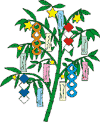
MoHS Japanese 2 Resources
Ebisuya-sensei, Fukada-sensei, Wong-sensei 2014-2015
These are the resources you need to complete the Tanabata Project. Please use them effectively.
Tanabata

Listen to the VoiceThread presentation on Tanabata and take notes on the Tanabata PPP Notes Sheet. Focus on the Products, Practices and Perspectives associated with this cultural event. You should be able to explain the significance of the various items and practices. You should also be able to explain how this cultural tradition has changed over the years and how it was influenced.
You may also view the presentation on a larger screen directly from VoiceThread here:
Tanabata is a celebration widely practiced in Japan. You will be participating in the following activities to understand the importance of and history behind celebrating this event and to recognize the products and practices associated with this celebration.
Activity #1: Listening Comprehension and Note-taking
Find at least 2 of your own articles or stories about Tanabata. Read the selections and take additional notes on the PPP Notes Sheet. Include additional important facts, ideas, concepts and values discussed in your articles. If concepts or key information appears in multiple sources, pay special attention. Keep in mind the importance of the facts shared. Cite all of your sources appropriately using the correct format on the back of the page.
Activity #2: Research and Note-taking
eXceeds
Meets
Emerging
Not met
Notes are complete and summarized using a graphic organizer, sites multiple sources beyond what was introduced in the presentation using the correct format.
Notes are complete and organized using some type of format, used at least one source other than what was introduced during class, cited all sources correctly.
Notes are incomplete, not summarized, used only introduced information without confirmation from other sources, sources not cited appropriately.
Notes are incomplete, sketchy, contain incorrect or information, includes no new information or organization, sources are not cited.
GLO 1
Activity #3: Summary & Understanding
Summarize your notes using the Influence Chart graphic organizer in the Influence and Essay Sheet to highlight the impact and influence of cultures by organizing and prioritizing important information, details that focus on the products, practices and perspective associated with this event. You may use multiple products, practices or perspectives to show the impact or influence of the cultures on each other. Explanations should include at least one example with explanation for each idea introduced.
eXceeds
Meets
Emerging
Not met
Information for events discussed are accurate and complete with all items entered into the correct areas. Evidence of influence and change are thoughtful, clear and accurate, with well thought out reasoning and go beyond the obvious.
Information about Tanabata is complete and accurate, with evidence of influence and change between cultures clearly explained.
Information about Tanabata is incomplete or not accurate and not entered into the correct areas. Influence between cultures is inaccurate or very shallow with vague explanations.
Information on Tanabata is sketchy, inaccurate and misplaced or missing all together. No influence is discussed.
2.4.1
Activity #4: Assessment
Complete the essay and acrostic poem on the last page of the Influence sheet. Use the printed sheet as your draft. The final essay and poem will need to be added to your Glogster poster.
eXceeds
Meets
Emerging
Not met
Position is clearly stated with supporting details and evidence carefully crafted to entice the reader to agree.
Position is clearly stated and supported by logical and connected evidence.
Position is not clearly stated with evidence that is unrelated, misleading and/or details do not support a point of view.
No clear position, with minimal, sometimes unrelated evidence.
2.4.1
Activity #5: Products
You will create a tanzaku containing 2 wishes using the correct format. You may also create another appropriate decoration to tie to the bamboo branch with your tanzaku. Ideas should be found in your research. Cite all sources appropriately in your notes. The following rubric will be used to assess the final product.
eXceeds
Meets
Emerging
Not met
Completes a tanzaku with an appropriate English wish and a simple, but accurate Japanese wish using the correct format. Creates another appropriate decoration and gets everything ready for hanging on a branch.
Completes a tanzaku with an accurately written wish in Japanese using the correct format and another, different, more complex wish in English. Gets it ready to hang on a branch. May do another decoration, but it is inappropriate or done incorrectly.
Does the wish or decoration but it contains errors, is not ready to hang on a branch, does not follow the directions. Japanese may be a translation of the English wish or written in a different form beyond what was introduced.
Does only a decoration, does not follow directions, does not complete the tanzaku or wishes. Wish may have been done by someone else, beyond the range of language ability.
2.4.2
Wishes should be written on the appropriate strips of paper. If you need a replacement, use a 6-8 x 2 inch strip of colored paper. You may decorate the paper, color it or draw appropriate designs.
One wish should be written horizontally in English, as seen in the sample given below. Do not just translate your English wish into Japanese.
The other wish must be a different, simple wish entirely written in Japanese if possible, but some single words may be written in English, if necessary. The wish should be a statement of fact (using です/ます forms) followed by ように。See the samples below.
Name, date and period should be written on the tanzaku for credit.
Decorations must be appropriate, accurate and neat. Also label with your
name, date and period.
Examples:
In Japanese, wishes are written as complete sentences in the ます form
with ように added to the end of the verb.
Examples:
I wish it will be sunny on Friday. きんようびははれていますように。
I wish for a good year. すばらしいいちねんがありますように。
I wish I will get a pet dog. ペットにいぬがもらえますように。
I wish for no more earthquakes. じしんがなくなりますように。
Need ideas for Tanabata decorations? Check out this site. You can always find your own, but this is a good place to start.
Need more of a challenge? Check this out!
http://cp.c-ij.com/en/contents/3158/tanabata-doll/index.html
Final Reflection:
Complete the following Reflection Sheet. It is a form, so you will need to sign into your school gmail in order to access it.





Tanzaku
Enter your tanzaku wish on this page: Click on the Padlet page, add your name and your wish in Japanese. Sensei added her wish.
Glog Checklist and Assessment:
Be sure you added all the appropriate content to your Tanabata Glog.
-
Title
-
PPP Chart or representation with significant details
-
Influence Chart or representation with significant evidence of understanding
-
Complete essay addressing the target question
-
Acrostic Poem
-
Picture of your tanzaku and decoration (if you did one)
-
Attachment or list of sources, cited appropriately (MLA)
-
Submitted as "finished"
Peer Assessment:
Complete the following Peer Assessment Sheet for the 3 projects you are assigned to review. It is a form, so you will need to sign into your school gmail in order to access it. You will need to open the 2 windows and keep them open side-by-side.
